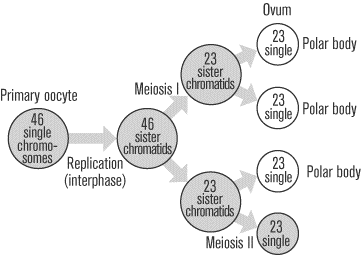Lesson: Chapter - 7
Spermatogenesis and Oogenesis
Meiosis, the process by which gametes are formed, can also be called gametogenesis, literally “creation of gametes.”
The specific type of meiosis that forms sperm is called spermatogenesis, while the formation of egg cells, or ova, is
called oogenesis. The most important thing you need to remember about both processes is that they occur through meiosis,
but there are a few specific distinctions between them.
Spermatogenesis
The male testes have tiny tubules containing diploid cells called spermatogonium that mature to become sperm. The basic function of spermatogenesis is to turn each one of the diploid spermatogonium into four haploid sperm cells. This quadrupling is accomplished through the meiotic cell division detailed in the last section.
Video Lesson - Spermatogenesis
During interphase before meiosis I, the spermatogonium’s 46 single chromosomes are replicated to form 46 pairs of sister chromatids, which then exchange genetic material through synapsis before the first meiotic division. In meiosis II, the two daughter cells go through a second division to yield four cells containing a unique set of 23 single chromosomes that ultimately mature into four sperm cells. Starting at puberty, a male will produce literally millions of sperm every single day for the rest of his life.

Video Lesson - Oogenesis
Just like spermatogenesis, oogenesis involves the formation of haploid cells from an original diploid cell, called a primary oocyte, through meiosis. The female ovaries contain the primary oocytes. There are two major differences between the male and female production of gametes. First of all, oogenesis only leads to the production of one final ovum, or egg cell, from each primary oocyte (in contrast to the four sperm that are generated from every spermatogonium). Of the four daughter cells that are produced when the primary oocyte divides meiotically, three come out much smaller than the fourth. These smaller cells, called polar bodies, eventually disintegrate, leaving only the larger ovum as the final product of oogenesis. The production of one egg cell via oogenesis normally occurs only once a month, from puberty to menopause.

Next to display next topic in the chapter.
Practice Questions
Test Prep Lessons With Video Lessons and Explained MCQ
Large number of solved practice MCQ with explanations. Video Lessons and 10 Fully explained Grand/Full Tests.